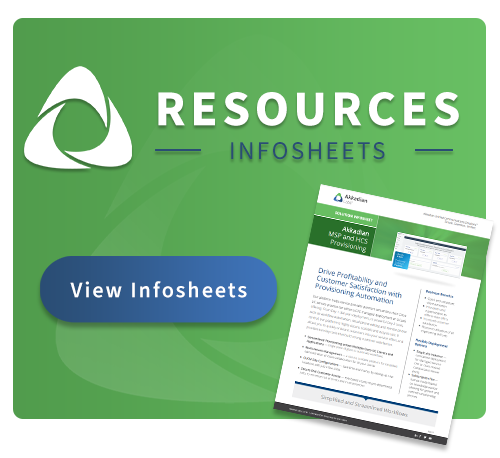UC management is a broad concept. In this article, we explore what it is, why it’s important for communications in a large enterprise, common challenges associated with UC management and how UC provisioning software can help solve those challenges.
Large-scale unified communications (UC) environments typically found in global enterprises are challenging to manage. With thousands of users and devices spread across the globe, creating a seamless communication network is a daunting task for many internal IT teams.
A sound UC management plan, aided by a UC provisioning automation platform, is needed to make it all work. In this guide, we dig deeper into UC management by covering the topics below.
- What is UC management?
- Who is responsible for UC management?
- Why is UC management important?
- Common UC management challenges
- How an automated provisioning platform helps
What is UC Management?
Unified Communications (UC) management is exactly what it sounds like. It refers to the administration and optimization of an organization’s unified communications environment.
UC management tasks generally involve overseeing all communication channels, including voice, video, messaging, and collaboration tools. It also involves managing the endpoints and devices used to access these channels. This means managing hardware, software, networks, and security protocols, all of which usually fall under the umbrella of UC management.
Additionally, UC management encompasses monitoring performance, troubleshooting issues, and implementing upgrades to support the organization’s communication needs effectively. With all this complexity, it begs the question, who is responsible for it?
Who is Responsible for UC Management?
As complex as UC management is, it’s only natural that it usually involves many different teams and stakeholders. The division of the responsibilities of UC management will depend on the needs of your enterprise and the teams you have available to you. Here’s a general breakdown of team responsibilities.
- IT Department: General IT teams are central in managing UC solutions. This includes tasks such as deployment, configuration, maintenance, troubleshooting, and ensuring the security of UC systems. If your enterprise lacks differentiation in your IT department, then all UC management tasks will fall to those employees. From there, they may choose to outsource tasks they are not as familiar with.
- UC or Telecommunications Teams: If your enterprise has a specialized telecommunications or UC team, then they will play an even more important role in managing your UC environment. These specialists are best suited to manage voice, video and messaging platforms, including VoIP systems and video conferencing technologies.
- Security Team: Communications data is sensitive, and hybrid work can expose enterprises to even more security threats. If your enterprise has a cybersecurity team, it should be responsible for implementing and maintaining security measures to protect UC systems from cyber threats, data breaches, and unauthorized access.
- Executive Leadership: Ultimately, it’s up to leadership like the CIO (Chief Information Officer) or CTO (Chief Technology Officer), to provide strategic direction on UC management. They hold the power to allocate resources and set policies related to UC management.
Why is UC Management Important?
Effective UC management is crucial for large enterprises, especially in today’s fast-changing work environment. More enterprises are adopting hybrid and remote work models, which makes managing a UC environment all the more challenging. In the midst of all this change, effective UC management allows for streamlined communication processes that foster collaboration among teams across the globe.
In addition to the internal benefits to your enterprise, effective UC management also improves customer service by enabling faster response times, more personalized interactions and . Moreover, effective UC management ensures data security and compliance with regulations, safeguarding sensitive information exchanged within the organization.
Unfortunately, there are many challenges that can get in the way of an enterprise achieving effective UC management. Let’s dive into what those look like.
The Top 5 UC Management Challenges Enterprises Face
Challenge #1: Interoperability in Hybrid Environments
Remote and hybrid work has only made UC environments more and more complex in many organizations. Instead of migrating from an on-prem environment to cloud-based UC, many organizations added cloud-based UC applications to their existing on-prem solutions. This has led to complex hybrid UC environments that make interoperability, UC management and provisioning tasks much more challenging and time-consuming.
Challenge #2: UC Migrations & Bulk Actions
Migrations and bulk actions are becoming more and more common, with many organizations deciding to make the switch to cloud-based UC platforms. Performing these migrations and bulk provisioning jobs without any automation solution can delay the overall project, wasting valuable time and resources. Also, bulk data moves done manually open up your project to the risk of many mistakes that can compound those delays.
Challenge #3: Scalability
As an enterprise grows, provisioning and UC management tasks only increase. Especially if your company runs a complex hybrid environment, provisioning and management task time will only increase exponentially without a way to automate and simplify the tasks.
Challenge #4: Security
In the past, UC applications like Call Manager, Unity Connection, Webex, Jabber, Teams and even Zoom have not always been attractive targets for hackers. However, attackers are looking for any way in, and these systems expose organizations to several operational risks. If hackers gain access to these applications, they can gain access to proprietary corporate communications, valuable company information and the devices that employees use to communicate. They can also take your systems down entirely, grinding communications and productivity to a halt.
Challenge #5: Resources
While UC management is important, it only plays a part in your company’s overall long-term IT success. There are likely many other IT initiatives that your organization likely has in progress at any point in time. Tying down your internal teams with manual UC management and provisioning tasks takes your employees’ time away from those more strategic projects.
How Automated UC User Provisioning Can Solve UC Management Challenges – 3 Main Benefits
Benefit #1: Risk Mitigation
Automated UC user provisioning software minimizes the security risks of granting access and deleting users in UC systems and applications. A key reason for this is roles-based access, which gives admins the ability to limit the access users have to your automated provisioning software through role designations.
These designations define who can access what jobs, templates, devices and settings. With this level of flexibility, your enterprise can customize what they feel their teams and users should get based on their internal best practices. These groups provide a common class of users with permissions and access to items within a provisioning automation solution, all with the aim of enabling more effective and secure UC management.
Benefit #2: Simplification & Consistency
Automated UC provisioning simplifies UC management by making set-up and execution consistent for many provisioning tasks.
Automating user provisioning tasks like onboarding, off-boarding and bulk moves means they get done the same way every single time. Pre-defined jobs and templates remove the manual intervention in UC account provisioning and eliminate variability in how different provisioners might configure accounts.
The right automated provisioning solution can even provision beyond your UC applications by integrating with other corporate systems in your tech stack. These can include:
- Active Directory (Microsoft AD)
- IT Service Management (ITSM)
- Identity and Access Management (IAM solution)
- Human Resources (HR Systems)
Once connected, an automated UC provisioning solution can act as a hub connecting user information across much of your corporate tech stack. User information can flow without any manual work from your IT team or a service desk, all allowing for more effective UC management.
Benefit #3: ROI
Automating provisioning and UC management tasks leads to dramatic time and cost savings. Those combine to lead to measurable ROI for your organization in many ways.
Automation makes work faster and more efficient. With an automated provisioning platform, UC management tasks that used to take hours or days will now take minutes to complete. Additionally, an automated provisioning platform with proper roles-based access allows you to pass provisioning tasks to a HelpDesk securely. This saves even more time for your UC and IT engineers
Automating UC user provisioning is a quick and easy way to save time and money, but beyond that, it can help you retain talented UC engineers.
Highly trained IT and UC professionals shouldn’t be stuck with repetitive provisioning work. It’s a waste of their time and talent and your company’s resources. On top of that, rote, repetitive work leads to burnout. When people are burnt out, they’ll look elsewhere for work.
Investing in provisioning and UC management automation can help you refocus your highly-skilled UC engineers on strategic projects. This gives them more engaging and challenging work to do, which increases their job satisfaction while increasing their impact on your organization at the same time.
All these factors can lead to game-changing ROI with minimal effort to implement.
Automated UC Provisioning Leads to More Effective UC Management
User provisioning can be all too easy to look over in all the complexity involved with UC management. However, an automated UC user provisioning platform can be key in streamlining UC management tasks. Automating these tasks ensures your company can more effectively communicate in the hybrid working world.
An automated provisioning platform ensures user provisioning work gets done right every time. This prevents outages and keeps your company more secure and connected, all while allowing your IT professionals and UC engineers to focus on more impactful strategic work.
Check out the Akkadian Provisioning Manager page to learn more about how we can help you achieve more effective UC management.



